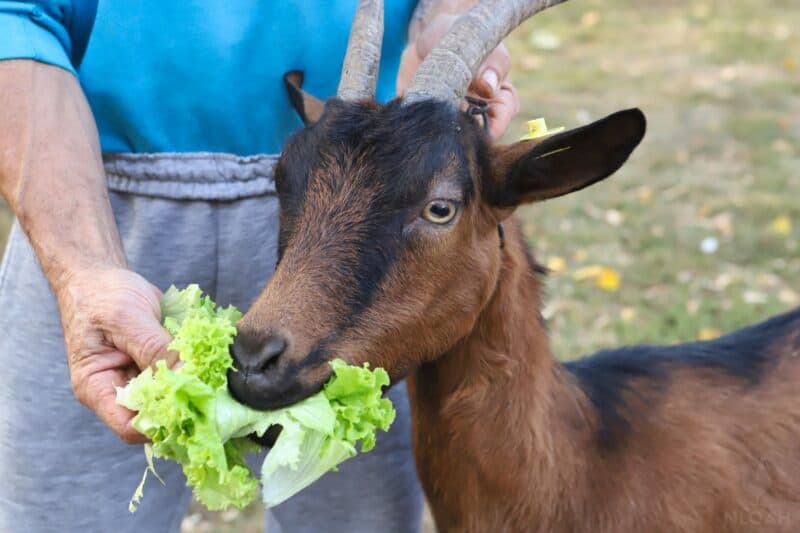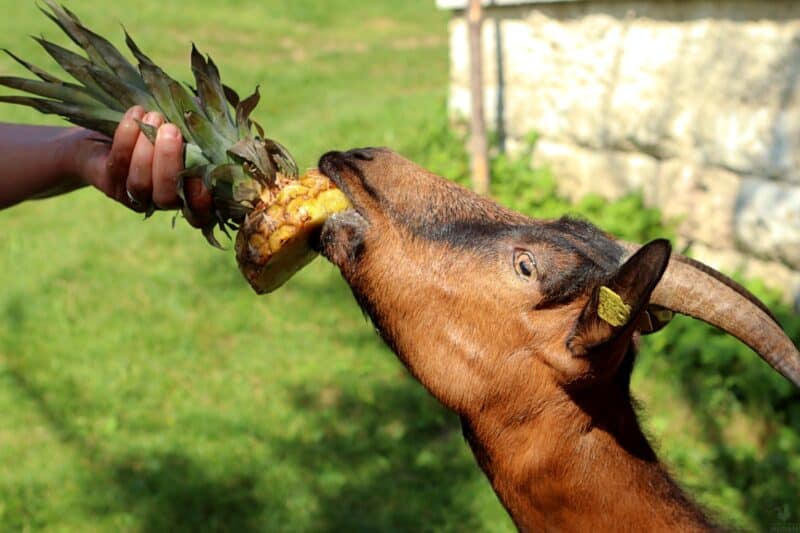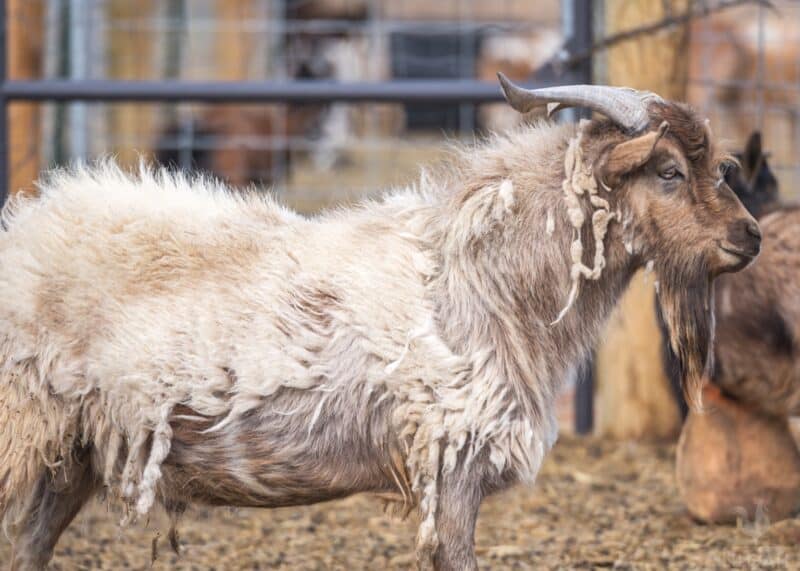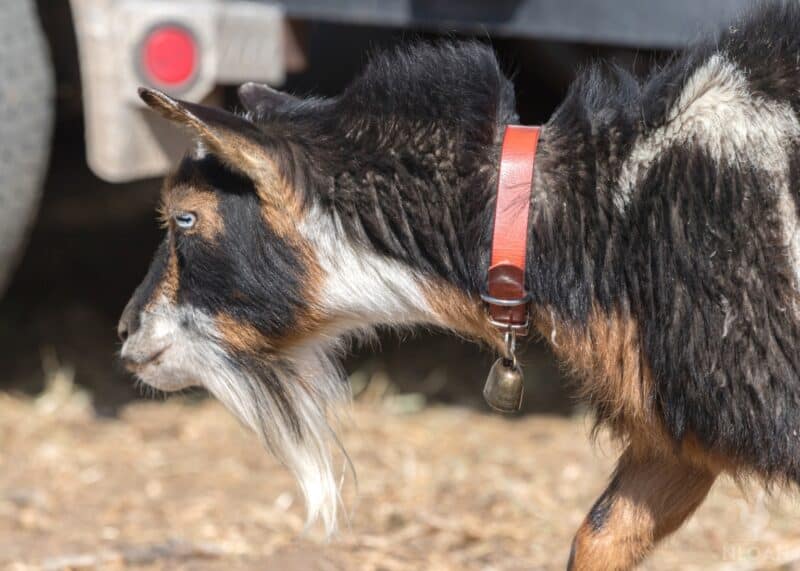You know that old saying, “familiarity breeds contempt”? When it comes to animals in our everyday lives, familiarity might not breed contempt but it does breed boredom. And when you look at common livestock animals like goats, it’s easy to forget that they are as amazing, interesting, and in many ways, surprising, as any exotic wild animal.

Whether you own goats yourself or not, there is a whole lot that you don’t know about them, that I can promise you!
To give you a little more appreciation for these incredible and rambunctious critters, I’m bringing you a list of 20 interesting facts about them that you probably didn’t know…
Goats Can Get Nutrients from Normally Indigestible Things
Goats have a reputation for being able to eat just about anything, and that’s not entirely true. What is true is that they can eat, and even survive on, certain things that other animals wouldn’t dream of.
For instance, goats can eat bark and even wood, breaking it down to extract nutrients from it. This is a survival strategy that helps goats survive in the arid and sometimes semi-barren places that they normally inhabit in the world.
In captivity, goats will eat flowers, shrubs, and other plants right down to the surface if you don’t watch them!
Goats Can Swim…
Most land animals have a reputation for being graceless in the water, and some of them don’t swim very well at all.
Believe it or not, goats are surprisingly capable swimmers and are known to take to the water to get away from predators, reach mates, or rejoin a herd when they get separated.
If they’re forced to, they also move pretty quickly in the water and have great endurance, meaning they can stay afloat for quite a while.
But They Don’t Like the Water!
Now, just because goats can swim doesn’t mean they enjoy it… Goats actually show a lot of hesitancy around bodies of water, and a sharp dislike of getting wet generally. Assuming they aren’t drinking it, of course!
Unless they have no other choice, goats will avoid the water at all times. They don’t even like getting rained on.
In fact, it’s a well-known trope among goat owners that their furry little charges will head for the nearest cover when it starts to rain, even when it’s just sprinkling. Don’t be surprised to see them huddling under a tree, in their shelter, or under anything else that will help keep them dry.
Goats are a Lot Smarter Than We Thought
Goats have a reputation for being dumb, stubborn, and intractable, but it turns out this might have been an act all along. Goats have been proven in recent years to possess remarkable intelligence, among their own kind and in their dealings with people.
For instance, goats remember and recognize faces, including the faces of people who have treated them well or treated them poorly.
It’s no exaggeration to say they will hold a grudge or look forward to seeing you based on how you interact with them. Likewise, they recognize human expressions and body language.
If you’re feeling upset from your day, goats are more likely to steer clear of you, but if you are relaxed and happy, they’ll be more likely to come up to you. Amazing!
Domestic Goats Have Learned to Manipulate People
On the subject of goat intellect, and this fact might unsettle you, they have learned how to manipulate people to get what they want. It’s true!
And the same way that cats and dogs will use eye contact with humans and modify their posture and expression to entice us to help them or give them what they want, goats have been shown to do the exact same thing.
A series of tests conducted by scientists, giving goats increasingly more difficult problems to solve to get food, culminated with a lid over a food container that was nearly impossible for a goat to open by itself.
Most of the animals that tested quickly resorted to giving nearby people a long and soulful stare in order to elicit help! Remember that the next time you are bringing them some treats…
Cashmere Fabric Comes from Goats
Cashmere fabric is one of the most beloved and luxurious in the world. But did you know it comes from goats? You bet!
Specifically, it is processed from goat hair in a laborious procedure that requires loads of hair from goats in order to make even a single garment.
Sure, goats might be smelly, nasty, and ornery but you can’t say that they aren’t versatile! Aside from milk and meat, they also give us some of the greatest textiles there are!

Goats are Surprisingly Picky Eaters
You know how I mentioned that goats really can’t eat just anything the way most people think? Yeah, you won’t see them eating tin cans, boots, and car doors unless something is already seriously wrong with them. I know it’s hard to believe that the cartoons lied to us…
Goats are, in fact, delicate eaters. That’s because they are browsers, meaning they roam around looking for the choicest, best bits of food from different plants and different sources.
They’re a lot more likely to visit their favorites on your property before roaming around looking for the tastiest bits and then moving on. They won’t necessarily clear-cut your entire yard like sheep and cows will unless they have no other choice.
Goats Have a Four-Chambered Stomach
You might have heard this fact before, that goats have four stomachs. They actually don’t, not really, but they do have a four-chambered stomach so it’s not far off.
This is because goats are ruminants, and slowly break down and digest food repeatedly for maximum nutrient extraction.
The four chambers of a goat’s stomach are the reticulum, rumen, omasum, and abomasum. Microbes start to break down, or pre-digest, food as it enters the first two compartments, and only in the latter two compartments do enzymes and digestive fluids start to do their work.
It’s a very slow process compared to the stomachs of people, dogs, and cats but it works for goats!
Don’t Try to Catch a Goat in the Dark
Think twice before you try to catch or round up your goats in the dark. They have remarkably good night vision! This is thanks to their wide and vaguely unsettling rectangular pupils.
It lets in a lot more light generally, including reflected light, and goats have a somewhat higher proportion of rods compared to people, meaning they see better in the dark and in failing light than we do.
Believe me, they will see you coming and avoid you if they don’t want to be caught and you’ll be stumbling around in the dark like a fool!
Goats See in Color
Goats are not color blind as most people assert. They do, though, have a limited color spectrum because they are dichromatic.
They have a set of cones that pick up blue light and another set that picks up green light, meaning they will see various shades and hues of both and then light and dark.
They don’t have a full-color spectrum vision like we do or the marvelous ultraviolet range of birds, but they see well enough for sure.
Goats Also Have Panoramic Vision
Another neat fact about goat vision is that they have panoramic, wrap-around views of the world! This is due to the shape, protrusion, and also positioning of their eyes on their head.
Depending on the breed and a few other factors, goats have a field of view that’s anywhere from 320 to 340° on the horizontal plane.
That means they can see nearly all around them without moving their heads; definitely a handy attribute considering they are prey animals!
Unless a predator approaches in total concealment or from a very specific angle, a goat will certainly see them coming. Like most prey animals, they also key on movement instantly so they can be prepared to flee.
Goats Don’t Have Upper Teeth
How’s this for a weird fact: goats don’t have upper teeth! They have lower teeth that they use to help them cut and chew food, but they have a hard, rubbery plate of flesh where their upper teeth would be, called a dental pad. You wouldn’t think they lack these teeth, though, unless you care to look because they can make short work of even the toughest stuff.
Watch them when they are out grazing, and you’ll even see them eating thorny plants and branches! Somehow, some way, it doesn’t seem to faze them.
Goats Can Be Great Pets
Goats are livestock animals, but they can be great pets too, as more people are starting to discover.
We already talked about how smart they are, and many breeds are naturally friendly and bond closely with people. They’re also active, and playful, and that makes them a ton of fun to be around.
Sure, they can be messy, and they have their own healthcare needs, but that’s not enough to deter most people who just love goats.
If you want a goat of your own, make sure you get at least two or three because they have to have the company of their own kind in order to stay healthy and thrive.
Goats Typically Have Long Lifespans
Here’s another jaw-dropping fact for you. Domestic goats, given good care, can live upwards of 15 years. Some can reach 18 years or even a little bit beyond!
That is truly incredible, and whether you have goats as pets or true livestock, you can be happy knowing that they’ll be with you for a big part of your life as long as you take care of them.
But, that’s also a really big responsibility and it’s not out of the question that you might need to account for your animals in your own end-of-life planning!

Fainting Goats Don’t Really Faint
Have you been on the internet for any length of time? If you have, I know you’ve seen fainting goats before. You know, the ones that get jump-scared and then fall over, stiff-legged, like they pass out from fright!
I hate to throw a big bucket of science on this funny phenomenon, but fainting goats don’t actually faint: they have a genetic disorder that, when they get startled, causes their muscles to lock up at full extension and that’s why they temporarily lose control.
It seems a bit sad, but there’s nothing to worry about because it doesn’t hurt them, and they live completely normal lives otherwise.
Goats Have Been Domesticated for Ages
Goats are some of the oldest domesticated livestock, with the current best guess from scientists and archaeologists is that goats were first domesticated anywhere from 10,000 to 11,000 BC.
We found goat remains mingled with those of settlements, houses, and cities, including equipment normally used to keep livestock like collars and so forth.
The very first domestic goats we know of were found around the Middle East and parts of Western Asia, specifically around what is modern-day Turkey and Iran.
Goats Might Headbutt for Fun!
If goats are known for one behavior it has to be head-butting. Whether they have horns or not, goats will deliver a headbutt in self-defense or when someone is challenging their space or territory… but they do it for other reasons too. Like for fun!
Baby goats will start out head-butting each other playfully, but still quite hard, when they are young, and adults will do the same thing. They’ll even try to headbutt you!
Even if you don’t want to participate, they’ll settle for whacking you in the leg or backside, so make sure you keep an eye on these mischievous critters!

Male and Female Goats Can Have Beards!
When you think of a male goat, also called a buck or billy goat, you likely imagine that long, scraggly beard that they have. This is indeed an iconic part of their physiology for most breeds, but females can have beards too.
Typically, they aren’t as prominent or as long as those found on bucks, but they’re definitely there! You’ll need to rely on identifying other parts if you want to tell the boys from the girls for sure!
Goats Can Be Pretty Quick!
Goats are known for remarkable agility and climbing skills, but they’re also quite fast when they’re running flat out! An adult on good terrain can reach a top speed of around 15 mph (24 kmh), maybe a bit faster!
Goats Can Climb Nearly Vertical Surfaces
And speaking of climbing, if you’ve never seen them do it in person you won’t believe how capable they really are…
Goats inhabit and thrive in steep, mountainous areas. They have a remarkably good sense of balance and positioning, and their durable, small hooves allow them to make use of even the tiniest footholds for climbing.
They’re such good climbers that, if the surface is sufficiently rough, they can scale a nearly vertical wall! Your car, shed, and other things on your property are no challenge at all.
Plenty of owners have come outside to be baffled at the sight of one of their goats standing out on a branch in a tree! You can wonder all you want, but what matters is that they can and will climb anything.

Tom has lived and worked on farms and homesteads from the Carolinas to Kentucky and beyond. He is passionate about helping people prepare for tough times by embracing lifestyles of self-sufficiency.
